Our Conservation Approach
Our project at East Taranaki is a community initiative, involving the implementation of a suite of pest control and advocacy measures to promote conservation and sustainability in the wider East Taranaki catchments. Our mission is to protect the eco-system and biodiversity in East Taranaki. Our approach to restoring the eco-system and increasing native biodiversity of our 18,000 hectare project area is through the control of invasive pest species.
We are proud to be one of the largest community environment schemes in New Zealand. Our pest operations through our trap network, toxin operations and goat control provide a place for kiwi, kōkako, long-tailed bats and other native species to thrive.
Department of Conservation are working on the feasability of the East Taranaki Corridor; Our project sits in the heart of this, along with work being done with local iwi. The trust is taking a collaborative approach, working alongside local iwi to establish this Eastern Corridor which will act as a refuge for native species. This will not only provide a corridor of national significance, but also build and develop a strong conservation workforce within Taranaki.
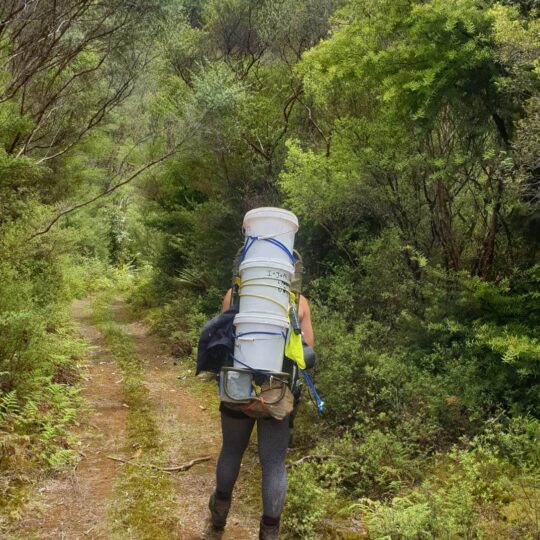

Biodiversity
The Trust aims to restore native biodiversity within the East Taranaki region and provide a protected area for native wildlife to thrive. This is mainly achieved through using an integrated pest management approach, where the main pest species are targeted and control is adapted based on findings. To ensure that the pest control regime is leading to biodiversity gains, the Trust monitors key indicator species such as kiwi and kōkako.
Our biodiversity conservation action plan, including interactions within the ecosystem, this is summarized in the picture.
Pest Control
Mustelid control
Stoats are the main mustelid targeted for control throughout the 18,000-hectare project area, though the Trust has been working over the past year to strengthen this mustelid control and include more targeted ferret control too. There are 1,300 DOC200 and 600 DOC250 traps set up across 31 different traplines, with each trap spaced 100m apart along traplines, and lines spaced 1km apart. Traps are checked, rebaited, and reset every month by contractors or staff. Different lures are frequently used to introduce something novel.
Ferrets are one of the main predators of adult kiwi, and in recent years they have been expanding their range and increasing in population size. This has resulted in ferrets being caught in areas that they haven’t been trapped in previously, and adult kiwi being predated on by ferrets. The Trust catches only a few ferrets each year within the project site, though this could be because the main trap used is the DOC200.
Ferrets are larger than stoats, and can’t fit easily into the entranceways of a DOC200, and the mechanism is not strong enough to kill them. The DOC250 is a slightly larger and more powerful trap, capable of trapping ferrets and stoats. Due to this, the Trust has been reviewing how to protect the area further from ferret incursions, and the peripheral traplines around the site have had every third DOC200 replaced with a DOC250. These traplines are close to edge habitat (areas where forest and farmland meet) which are likely to have more ferrets due to higher rabbit populations in these areas. By targeting the ferrets within the periphery (similar to a halo) it will reduce the chances of ferrets moving further into the core part of the forest.
Camera traps are also being utilised within the Pouiatoa Conservation Area to detect any ferret incursions that may occur
Rat and possum control
Rats and possums are controlled within 1000 hectares of the Pouiatoa Conservation Area through a number of different methods. The main reason for this is that it is where the reintroduced kōkako have settled, and kōkako need low rat and possum populations to be able to breed and nest successfully.
To help keep rats and possums suppressed year-round, there is a network of 342 A12 and 797 A24 Good Nature resetting traps set up over 1,000 hectares of the Pouiatoa Conservation Area. A12s are mainly set up on the perimeter tracks with 100m spacing and target possums, and A24s are set up on the perimeter and interior lines with 50m spacing and target rats. These are regassed and relured every six months.
Yearly ground toxin operations take place in between 1080 years (the Trust is on a 3 yearly cycle). Within the 1,000 hectare Pouiatoa Conservation Area core block there are over 451 bait stations set up. Toxin operations are undertaken based on pre monitoring results. Tracking tunnels are used to monitor rats, and wax tags and chew cards are set up to monitor possums. Camera traps are also used. The Trust is continually assessing their pest control to make sure that it is effective and efficient as possible.
Goat control
Goat control is important for the long-term health of the forest as well as regeneration in the understory. The thinning of the forest canopy over time can lead to increased predation rates on nesting birds. Goats also reduce the fruiting trees important for kōkako and other birds during the breeding season, and reduce the food availability for native wildlife.
The Trust is thankful for the help of the Department of Conservation. The Department of Conservation has provided funding support and helped with the logistics for goat control to be undertaken within the Pouiatoa Conservation Area. This has resulted in 447 hours of hunting and 756 goats removed from the Pouiatoa Conservation Area or surrounding farmland in the July 2021 – June 2022 financial year. In July 2022 – June 2023, there were 548 hours of goat hunting with 952 goats shot within the Pouiatoa Conservation Area and surrounding farmland.
ETET will be working with the Department of Conservation to continue this goat control work to ensure the long-term survival of the forest and increase the regeneration of vegetation.
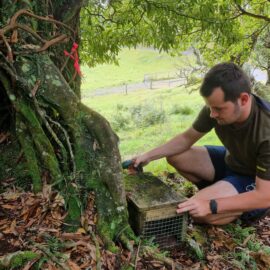
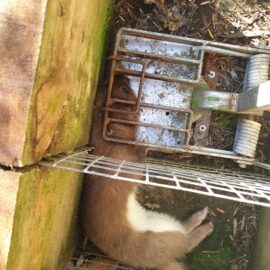
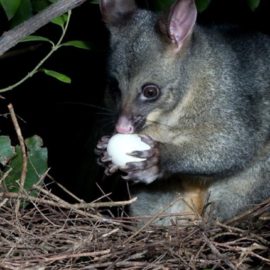
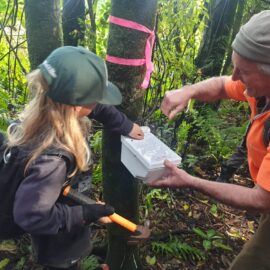
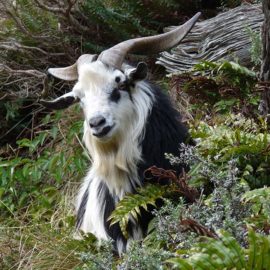

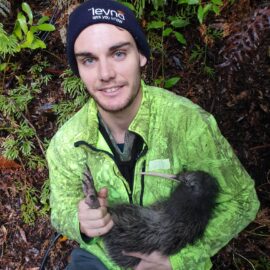
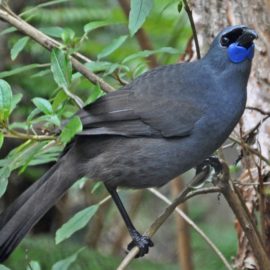
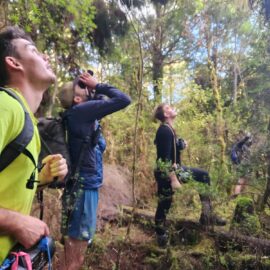
Native species monitoring
East Taranaki Environment Collective takes a science-based approach to conservation work, by using several indicator species to demonstrate the effectiveness of our pest control programmes. While pest control is at the core of our work to restore the ecosystem, we monitor kiwi, kōkako, and other species to indicate whether we are successfully reducing predator populations, and if this has a positive flow on effect on wildlife.
Kiwi
The national kiwi recovery plan indicates that the kiwi population is declining at 2% pa. It is estimated that there are about 68,000 kiwi left in New Zealand. If Kiwi populations are declining by about 2% per year in areas where predators are uncontrolled – that’s about 20 per week.
If we don’t provide predator control 95% of kiwi chicks will be killed, and as the older kiwi die out the population will implode, and as a result we will lose our iconic taonga. Our long standing pest control network is a success story, helping to turn a declining population into one which is growing.
ETEC’s efforts significantly contribute to the recovery of the western North Island brown kiwi, with our project supporting an estimated population density of one pair per 12.5-15 hectares.
Kōkako monitoring
Fewer than 2000 pairs of kōkako currently exist in New Zealand. Without intervention extinction of the populations and loss of their particular genetic lineages are certain. The last kōkako to be seen in the the East Taranaki forest was around 1989. Since East Taranaki Environment Trust’s inception in 2005, kōkako re-establishment has been a part of our long term vision.
In 2010 we identified a core block within our project which had suitable habitat to reintroduce kōkako. Since then we have undertaken intensive predator control to ensure the habitat has flourished to provide a place for them to thrive. In 2018 the first 20 manu (birds) were caught on Hauturu Island and moved to our project. The goal of this was to establish a self-supporting population which can contribute to the wider kokako recovery plan and the restoration of the overall ecological system.
In September of each year our field team conducts a census survey within the 1,000-hectare kōkako core block within the Pouiatoa Conservation Area. In September 2021 the team covered over 50km of tracks and had a successful year, with the team identifying 13 kōkako and hearing at least another 3 birds. There were five pairs identified with potentially another pair being located, and there are at least 5 unbanded kōkako in the area.
Over a period of nine days from September-November 2022, the team surveyed the Pouiatoa Conservation Area (and its surrounding areas) for kōkako territories. In total, 1450 hectares and 39 km of tracks were surveyed. Six pairs were found, along with four single birds seen. One pair was heard but not contacted during the survey (seen before surveys) and another five single birds were heard, also not contacted. Of the 16 birds seen, three were identified as being banded, twelve un-banded and one unable to be confirmed either way. Eight of these un-banded birds were in a pair, including three pairs of un-banded birds.
In September – November 2023 the team identified 7 pairs – which is incredible! There are a few stable pairs that have been in the same area for a number of years, so there is a great anchoring population. This is great news because it means that there are some breeding pairs within the Pouiatoa, and that the kōkako chicks are surviving.
